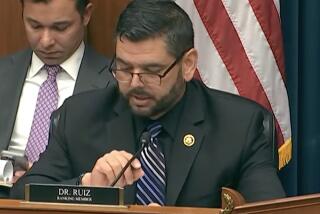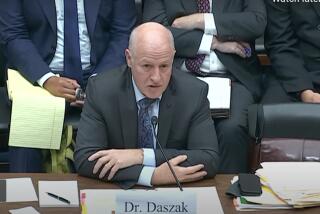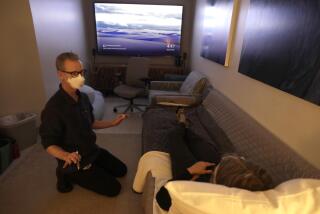Curbs on Outside Deals at NIH Urged
WASHINGTON — The National Institutes of Health should publicly disclose all drug company payments to its scientists, and should bar employees from accepting stock or stock options from industry, according to a draft report from a panel examining conflict of interest at the agency.
The report stops short of calling for a ban on company consulting deals with NIH scientists, but it recommends that the agency block top officials from participating in such arrangements. A copy of the report was obtained by the Los Angeles Times.
The federal panel, called the NIH Blue Ribbon Committee on Conflict of Interest Policies, recommends that paid consulting not exceed 500 hours a year and that “special scrutiny be applied” if outside compensation exceeds half of an employee’s yearly salary at NIH.
The committee compiled the recommendations in recent weeks as it prepared to present its final report to NIH Director Elias A. Zerhouni in early May.
If implemented by Zerhouni, the recommendations would reverse many actions taken by the agency in 1995 that loosened conflict-of-interest standards, including allowing NIH scientists to spend unlimited time consulting for outside employers, with no ceiling on the resulting income.
Zerhouni appointed the 10-member committee after The Times reported in December that NIH employees had accepted hundreds of payments of company fees and stock options, totaling millions of dollars.
Directors of two of the NIH’s research institutes -- whose government salaries are $200,000 and $225,200 -- received company fees or stock options worth hundreds of thousands of dollars. More than 94% of the top-paid NIH employees were not filing public income-disclosure reports.
At a congressional hearing Jan. 22, Sen. Arlen Specter (R-Pa.), who chairs the subcommittee that approved NIH’s $27.9-billion budget, warned Zerhouni to make major changes.
In the House, Rep. James C. Greenwood (R-Pa.), chairman of the Oversight and Investigations subcommittee, said NIH policies had led to, not a revolving door, but a “swivel chair” in which agency employees were paid simultaneously by the public and by industry.
Related inquiries have been opened by the inspector general of the Department of Health and Human Services and by the General Accounting Office, the investigative arm of Congress.
Meanwhile, the work of the blue ribbon committee is being watched closely by officials at NIH, by congressional leaders and by industry.
The blue ribbon committee’s co-chairmen, Bruce Alberts, president of the National Academy of Sciences, and Norman D. Augustine, retired chairman of Lockheed Martin Corp., said this week that they would not discuss the committee’s conclusions until a final report was submitted to Zerhouni.
Zerhouni was traveling Thursday and not available for comment, an NIH spokesman said. The spokesman said members of the committee were continuing to discuss the recommendations they would make.
Near the outset of their work, Alberts and Augustine met privately with Specter and the senior Democrat on the Appropriations subcommittee, Sen. Tom Harkin (D-Iowa). According to an aide to Harkin, the senator emphasized his desire for drastically increased public disclosure of outside payments received by NIH employees.
Harkin also voiced strong opposition to the payments of company stock or stock options to NIH employees and warned that, if he regained chairmanship of the subcommittee, he would demand changes.
“He’s interested, he has a lot of concern and he wants to see the report before he comes to any final conclusions,” said Harkin’s aide.
Much of the committee’s work has been closed to the public.
From March 1 through Tuesday, the committee had met during parts of four days in public and at least that many times in private. Although its members have spoken by phone or in person with all 27 directors of NIH research institutes or centers, only two have appeared in public sessions. The committee members have not discussed in a public session whether it is appropriate for the directors to accept consulting payments from a drug company.
Three of the NIH directors who have met privately with the committee told The Times this week in e-mails that they regarded the payments as inappropriate.
“I do not believe that institute or center directors at NIH should accept compensation from pharmaceutical or biotechnology companies in the future,” said Dr. Anthony Fauci, director of the National Institute of Allergy and Infectious Diseases. “Receiving compensation from one or more of these for-profit organizations creates a precarious situation for a director that in my mind is best avoided.”
Dr. Stephen E. Straus, director of the National Institute of Complementary and Alternative Medicine, said: “Institute or center directors should not consult for money with drug or biotech companies to avoid any real or perceived conflicts of interest in the decisions they are entrusted to make.”
Dr. Francis Collins, director of the National Human Genome Research Institute, said: “The credibility and integrity of the NIH are critically important. Therefore I believe that, in the future, institute and center directors should forgo arrangements involving financial compensation from pharmaceutical or biotechnology companies.”
Zerhouni, a radiologist who was appointed NIH director two years ago by President Bush, has said that he will make necessary policy changes. In addition to forming the committee, Zerhouni in recent weeks forced up to 93 top-level NIH decision makers to begin filing yearly income-disclosure reports that would be open to public inspection.
Zerhouni also announced that, as of late January, none of the directors of the NIH’s research institutes or centers were still accepting compensation from drug companies.
Nonetheless, Zerhouni has said that he prefers case-by-case decisions over outright prohibitions against company consulting fees for most NIH scientists.
“You can have a policy that says, ‘All right, all prohibited,’ ” Zerhouni told reporters last month. “But how does that help the public in terms of translating the discoveries in our laboratories into real things?”
Yet NIH has a separate and tightly controlled way to translate its discoveries into marketable remedies: cooperative research and development agreements. Staff scientists throughout NIH have entered into at least 1,300 such agreements with biomedical companies since Congress passed legislation in the 1980s authorizing the pacts, according to agency officials. Controls surrounding the pacts discourage conflicts of interest by barring NIH employees who are involved with the agreements, and for a year or more afterward, from accepting any payment from a participating company.
“[The agreements] are designed to encourage government scientists to work with private sector scientists in order to speed the translation of research findings to the marketplace,” Barbara M. McGarey, an NIH lawyer, told the committee last month. “The result is that government research doesn’t sit around and never get developed into products, she added.
When McGarey described the cooperative agreements last month to the committee, she elicited surprised reactions.
“This is a very vigorous program,” said Alberts, the committee’s co-chairman. “I didn’t realize this was so big.”
Yet in its draft recommendations, the committee says paid consulting deals, apart from the formal agreements, are “essential to accomplishing the goal of technology transfer.”
In a statement filed with the committee on April 1, the Biotechnology Industry Organization said that paid consultations with NIH employees “are of significant benefit to biotechnology companies in focusing their research and development activities.”
Dr. Drummond Rennie, a professor of medicine at UC San Francisco and a critic of corporate influence in medical research, said the NIH committee had a crucial opportunity to help restore integrity. Any compensation paid by industry to NIH scientists, he said, undermines the agency’s research agenda and results.
“Research is going down the toilet if nobody can believe it, or if it has been distorted,” said Rennie, who also is a deputy editor for the Journal of the American Medical Assn. “The obvious answer is a very simple one: You pay these folk enough to make them competitive. And then you say, ‘That’s it. You take nothing else.’ ”
Based on figures presented to the blue ribbon committee by NIH staff, salaries for most of the agency’s scientists are on a par with researchers in academia. The NIH is less competitive at the highest ranges of pay, above roughly $150,000, because the government generally caps salaries at $200,000 a year, according to the staff presentations.
Times staff writer Jon Marino in Washington and researcher Janet Lundblad in Los Angeles contributed to this report.
*
(BEGIN TEXT OF INFOBOX)
National Institutes of Health
Headquarters: About 300 acres in Bethesda, Md.
Mission: “NIH is the steward of medical and behavioral research for the nation. Its mission is science in pursuit of fundamental knowledge about the nature and behavior of living systems and the application of that knowledge to extend healthy life and reduce the burdens of illness and disability.” -- from NIH mission statement
Founded: In 1887 as the Laboratory of Hygiene.
Organization: 27 institutes and centers committed to an array of scientific specialties; a research hospital with a laboratory complex.
Affiliation: Part of the U.S. Department of Health and Human Services.
Staff: About 18,000 employees; some 45,000 fellows, research grant recipients and trainees.
Budget (In billions) 2004 (estimate): $27.9 billion 1990: $7.6 billion Fiscal year ended Sept. 30
Source: NIH website
More to Read
Sign up for Essential California
The most important California stories and recommendations in your inbox every morning.
You may occasionally receive promotional content from the Los Angeles Times.











